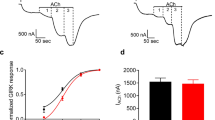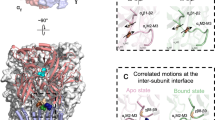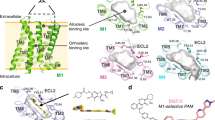Abstract
Muscarinic acetylcholine receptors (mAChRs), like many other neurotransmitter and hormone receptors, transduce agonist signals by activating G proteins to regulate ion channel activity and the generation of second messengers via the phosphoinositide (PI) and adenylyl cyclase systems1,2. Human mAChRs are a family of at least four gene products which have distinct primary structures, ligand-binding properties and patterns of tissue-specific expression3. To examine the question of whether functional differences exist between multiple receptor subtypes, we have investigated the ability of each subtype to regulate PI hydrolysis and adenylyl cyclase when expressed individually in a cell lacking endogenous mAChRs. We show that the HM2 and HM3 mAChRs efficiently inhibit adenylyl cyclase activity but poorly activate PI hydrolysis. In contrast, the HM1 and HM4 mAChRs strongly activate PI hydrolysis, but do not inhibit adenylyl cyclase, and in fact can substantially elevate cAMP levels. Interestingly, the subtypes that we find to be functionally similar are also more similar in sequence. Our results indicate that the different receptor subtypes are functionally specialized.
This is a preview of subscription content, access via your institution
Access options
Subscribe to this journal
Receive 51 print issues and online access
$199.00 per year
only $3.90 per issue
Buy this article
- Purchase on Springer Link
- Instant access to full article PDF
Prices may be subject to local taxes which are calculated during checkout
Similar content being viewed by others
References
Stryer, L. & Bourne, H. A. Rev. Cell Biol. 2, 391–419 (1986).
Nathanson, N. A. Rev. Neurosci. 10, 195–236 (1987).
Peralta, E. et al. EMBO J. 6, 3923–3929 (1987).
Hammer, R. et al. Nature 283, 90–92 (1980).
Birdsall, N. & Hulme, E. Trends Pharmac. Sci. 4, 459–463 (1983).
Watson, M. et al. Trends Pharmac. Sci. 7, 46–55 (1986).
Gil, D. &. Wolfe, B. J. Pharmac. exp. Ther. 232, 608–616 (1985).
Berridge, M. J. A. Rev. Biochem. 56, 159–193 (1987).
Nishizuka, Y. Science 233, 305–312 (1986).
Yoshimasa, T. et al. Nature 327, 67–70 (1987).
Salter, R., Krinks, M., Klee, C. & Neer, E. J. biol. Chem. 256, 9830–9833 (1981).
Hughes, A. & Harden, T. J. Pharmac. exp. Ther. 237, 173–178 (1987).
Rabe, C., Delorme, E., Weight, F. J. Pharmac. exp. Ther. 243, 534–541 (1987).
Korc, M., Ackerman, M., Roeske, W. J. Pharmac. exp. Ther. 232, 608–616 (1985).
Peralta, E. et al. Science 236, 600–605 (1987).
Kubo, T. et al. Nature 323, 411–416 (1986).
Kubo, T. et al. FEBS Lett. 209, 367–372 (1986).
Dixon, R. et al. Nature 321, 75–79 (1986).
Nathans, J., Thomas, D., Hogness, D. Science 232, 193–200 (1986).
Peralta, E. et al. Trends in Pharmacol Sci. February Suppl. 6–11 (1988).
Cockcroft, S. & Gomperts, B. D. Nature 314, 534–536 (1985).
Bray, P. et al. Proc. natn. Acad. Sci. U.S.A. 84, 5115–5119 (1987).
Fukuda, K. et al. Nature 327, 623–625 (1987).
Uhler, M. & McKnight, G. S. J. biol. Chem. 262, 15202–15207 (1987).
Coussens, L. et al. Science 233, 859–866 (1986).
Ashkenazi, A. et al. Science 238, 672–675 (1987).
Berridge, M. J., Downes, C. & Hanley, M. R. Biochem. J. 206, 587–595 (1982).
Eaton, D. L. et al. Biochemistry 26, 8343–8347 (1986).
Gorman, C., Padmanabram, R. & Howard, B. Science 221, 551–553 (1983).
Schimerlik, M. & Searles, R. Biochemistry 19, 3407–3413 (1980).
Author information
Authors and Affiliations
Rights and permissions
About this article
Cite this article
Peralta, E., Ashkenazi, A., Winslow, J. et al. Differential regulation of PI hydrolysis and adenylyl cyclase by muscarinic receptor subtypes. Nature 334, 434–437 (1988). https://doi.org/10.1038/334434a0
Received:
Accepted:
Published:
Issue Date:
DOI: https://doi.org/10.1038/334434a0
This article is cited by
-
Clinical Effectiveness of Muscarinic Receptor-Targeted Interventions in Neuropsychiatric Disorders: A Systematic Review
CNS Drugs (2022)
-
Structural mechanism underlying primary and secondary coupling between GPCRs and the Gi/o family
Nature Communications (2020)
-
Improved cognition without adverse effects: novel M1 muscarinic potentiator compares favorably to donepezil and xanomeline in rhesus monkey
Psychopharmacology (2015)
-
Selective phosphorylation modulates the PIP2 sensitivity of the CaM–SK channel complex
Nature Chemical Biology (2014)
-
The C. elegans VIG-1 and FRM-1 Modulate Carbachol-Stimulated ERK1/2 Activation in Chinese Hamster Ovary Cells Expressing the Muscarinic Acetylcholine Receptor GAR-3
Neurochemical Research (2014)
Comments
By submitting a comment you agree to abide by our Terms and Community Guidelines. If you find something abusive or that does not comply with our terms or guidelines please flag it as inappropriate.



